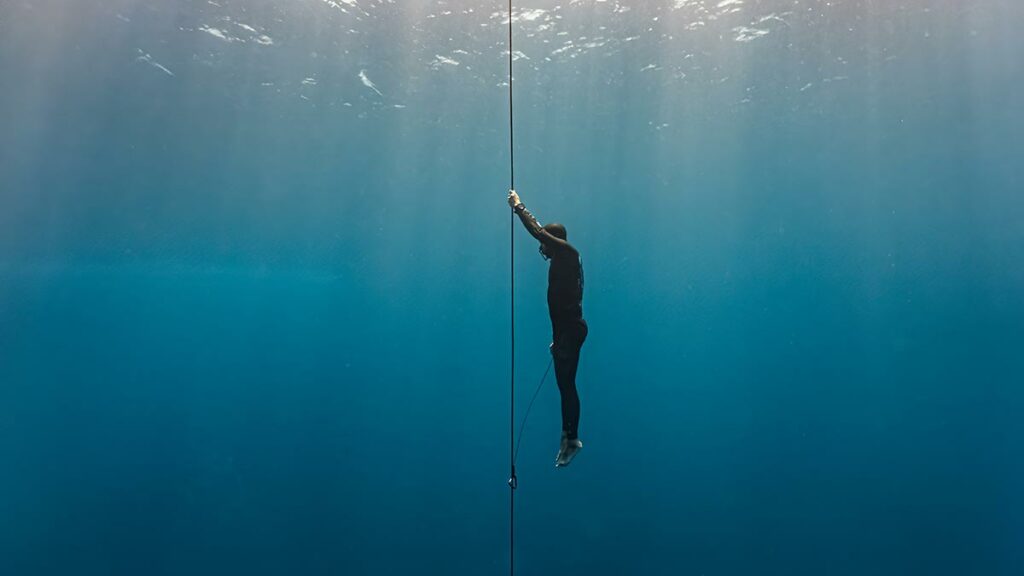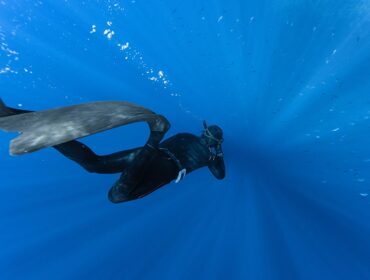Freediving, the art of diving on a single breath, is both thrilling and demanding. At the heart of freediving lies the delicate balance between pushing personal limits and ensuring one’s safety, a balance that a dive computer helps manage. It meticulously tracks your depth and dive time, two critical parameters that govern the safe practice of freediving.
The importance of a freediving computer cannot be overstated. It acts as a digital buddy, monitoring your dive time, depth, and ascent rate. It provides vital alerts that help avoid potential dangers such as shallow water blackouts or decompression sickness. For the safety-conscious freediver, it’s an essential piece of gear that offers peace of mind by keeping track of limits and ensuring sufficient surface intervals.
Whether you’re a beginner looking to make your first purchase or an experienced freediver seeking to upgrade your freediving equipment, this guide will provide the insights you need to make an informed decision. We’ll also discuss maintenance tips to ensure your chosen device stays reliable after diving.
Understanding Freediving Computers
Purpose of a Freediving Computer
A freediving computer is a specialized wrist-worn device engineered to assist freedivers by providing real-time data about their dives. Its primary function is to measure how deep and how long you’ve dived while keeping track of surface intervals—the time spent at the surface between dives. These measurements are critical for helping divers manage their physiological limits and safety while exploring beneath the waves.
The purpose of such a device extends beyond mere measurement; it includes various safety features. It typically offers customizable alarms that notify divers when they reach specific depths or when it’s time to begin their ascent. Moreover, it keeps historical data, allowing divers to analyze their performance over time, track improvements, or address concerns in their diving patterns.
Freediving computers often include additional features to enhance the dive experience, such as water temperature readings, a digital compass, and even information about the diver’s heart rate, provided there’s compatibility with a separate heart rate monitor.

Distinguishing Freediving Computers from Scuba Diving Computers
The fundamental difference between freediving computers and scuba diving computers lies in their target use. Freediving computers are optimized for the unique aspects of breath-hold diving. They have more sensitive depth sensors and quicker refresh rates to accurately monitor the rapid ascents and descents that characterize freediving. Additionally, they meticulously track the surface recovery times, which is paramount for breath-hold divers to avoid hypoxia and other risks.
On the other hand, scuba diving computers are designed to manage decompression limits and no-fly times, essential for divers breathing compressed air at depth. They use algorithms to calculate the nitrogen absorption in the body, which is not a concern in breath-hold freediving, where divers do not inhale pressurized gas, which could lead to decompression sickness.
While some dive computers offer modes for both scuba and freediving, dedicated freediving computers are typically more focused on the features that are most beneficial to freedivers. They prioritize a quick interface, easy-to-read display under varying light conditions, and audible and palpable alarms, considering freedivers may experience ear barotrauma that could affect hearing.
In essence, freediving computers are tailored to the dynamic nature of freediving, enabling enthusiasts to concentrate on the serenity and challenge of the sport with an assurance of safety and performance tracking.
See below for some of our top Freediving Computers from brands, including Seac and Tusa:
How to Choose a Freediving Computer
When selecting a freediving computer, certain features are pivotal for an optimal underwater experience. These include:
Depth Measurement Accuracy
The cornerstone of a reliable freediving computer is its ability to measure depth with precision. Accuracy is critical as it informs the diver of their exact underwater position, which is crucial for abiding by planned dive profiles and safety margins. Look for computers with a reputation for precision, often substantiated by high-quality sensors and positive user feedback.
Surface Interval Timing
Proper surface interval timing is vital for safety, allowing adequate time for the body to recover and expel accumulated carbon dioxide, which reduces the risk of hypoxic blackouts on subsequent dives. A good computer will provide clear and precise surface interval timing, a feature that helps divers adhere to safe diving practices.
Dive Time and Depth Alarms
Alarms for dive time and depth are essential for keeping divers within their planned limits. These alarms can be pre-set based on personal preferences or training goals. They should be distinct and discernible underwater, ensuring the diver is alerted effectively when a threshold is reached.
Water Temperature Readings
Water temperature can affect diving comfort and safety, and sudden temperature changes can signal different water currents or environmental conditions. Thus, a freediving computer that provides accurate water temperature readings is an invaluable tool for environmental awareness.
Display Readability
Underwater visibility can vary greatly, and the computer’s display must be clear and readable in all conditions. A good display will have a backlit screen with a high contrast ratio, large digits, and an intuitive layout to ensure information is quickly and easily discerned at a glance.
Battery Life and Type
For a freediving computer long battery life is crucial to avoid mid-dive power losses, and the type of battery — user-replaceable or rechargeable — affects the usability and maintenance of the device. User-replaceable batteries offer on-the-go convenience, while rechargeable ones can be more cost-effective and environmentally friendly over time.
Data Storage and Transfer Capabilities
Adequate data storage allows divers to log and analyze their dives over time, critical for tracking progress and planning future dives. Transfer capabilities, such as Bluetooth or USB connections, enable divers to upload their dive data to computers or smartphones for deeper analysis, social sharing, or backup.

Considerations for Beginners vs. Advanced Freedivers
The selection of a freediving computer should align with the diver’s experience level. Beginners and advanced freedivers have different needs, and the market caters to both with various features and functionalities.
Simplified Computers for Newcomers to the Sport
For those new to freediving, a simplified computer that covers the basics is often the best choice. Best freediving computers for beginners should have user-friendly features, with intuitive navigation and easy-to-understand displays. Key features for newcomers include:
- Basic depth and time tracking: To keep a clear log of dive depth and duration.
- Simple surface interval timing: Essential for safety during repeated dives.
- Pre-set alarms: To alert the diver when they are approaching their personal limits.
Such computers are usually more affordable and provide the essential functions required to dive safely without overwhelming the user with complex data and configurations.
Advanced Analytics for Experienced Divers
Advanced freediving computers should offer detailed analytics as they are meant for experienced divers who train for depth, time, or competitive events. These divers benefit from features like:
- Thorough dive profile analysis: Review the dive in-depth and make precise adjustments to the technique.
- Temperature and heart rate monitoring: To comprehensively understand the body’s response to different depths and durations.
- Customizable water activation: Allowing experienced divers to set the depth at which the computer turns on and begins recording.
Customization Options for Alarms and Displays
Customizing alarms and displays is important for divers of all levels but becomes increasingly useful for advanced freedivers who may have specific training goals and preferences. They might need to set multiple alarms for depth, time, and ascent rate, which can vary from one dive to the next. The display customization is also crucial; experienced freedivers may prefer to see more or less data on the screen during their dive, depending on their focus area.
Customization can include:
- Adjustable brightness and screen layout: For optimal readability under varying light conditions.
- Selectable alarms: Divers can choose what type of alarms they need, such as visual, auditory, or vibration alerts.
- Personalized data display: Options to prioritize displaying specific dive metrics over others.
When choosing a freediving computer, divers must consider their experience level and what they need from the device. Beginners should prioritize ease of use and essential safety features, while advanced divers may opt for detailed analytics and customizable freediving watches to fine-tune their training and performance.

Advanced Functions and Technologies in Freediving Computers
As freediving computers evolve, they incorporate more sophisticated functions and technologies that offer enhanced experiences and greater convenience for divers. Here are some of the advanced features to consider:
GPS Features
Modern freediving computers with Global Positioning System (GPS) capabilities provide significant advantages. They can pinpoint your exact location when you start and end your dive, which is incredibly helpful for mapping dive sites and tracking surface swimming routes. GPS features are also invaluable for safety, allowing for quick location sharing in emergencies on the surface.
Wireless Connectivity (Bluetooth, Wi-Fi)
Wireless connectivity in freediving computers, such as Bluetooth and Wi-Fi, has revolutionized data management and device integration. With Bluetooth connectivity, divers can effortlessly pair their computers with other devices. Such as smartphones or tablets, enabling them to download dive data to dedicated apps for analysis. Wi-Fi capabilities can further enhance this by allowing data syncing to cloud-based platforms, ensuring that dive logs are backed up and accessible from anywhere.
Integration with Mobile Apps
Integrating freediving computers with mobile apps extends the device’s functionality beyond the dive itself. These apps can provide a user-friendly interface to review and share dive data, plan future dives, and even offer training programs and tips. They often include social features that allow you to connect with a community of divers, compare performances, and participate in challenges.
User-replaceable Batteries vs. Rechargeable Options
The debate between user-replaceable and rechargeable batteries in freediving computers is a matter of personal preference and practicality. User-replaceable batteries can be convenient for those who travel to remote locations and need the ability to switch out batteries quickly. On the other hand, rechargeable batteries are eco-friendly and can be more economical over the long term. They also tend to power more advanced features that draw more energy. When considering battery options, consider how often you dive, where you dive, and your access to power sources or battery replacements.
Apnea Computers
The term “apnea computer” is often used interchangeably with “freediving computer,” but in some contexts, it can imply a more specialized focus on static apnea (breath-hold time while stationary). Dynamic apnea (horizontal distance covered on a single breath) is a discipline within freediving.
Specialized apnea computers and apnea diving watches are designed for static and dynamic apnea, focusing on breath-hold time and distance covered in a single breath. They feature static apnea timers for breath-hold training and may track time and distance during dynamic apnea sessions. These computers often have less emphasis on deep-diving functionalities, as depth is less critical in static and dynamic apnea. They also include training programs to enhance breath-holding capabilities, which are typically more compact and reflect the specific needs of apnea activities.
These advanced functions and technologies differentiate a standard freediving computer from a state-of-the-art one. When deciding on a device, consider how these features align with your diving practices, safety requirements, and preferences for convenience and connectivity.

Freediving Computers Maintenance Tips
Proper care and maintenance of a freediving computer are critical to ensure its longevity and reliability. Here are some essential guidelines:
Cleaning After Each Dive
To maintain the functionality and appearance of the freediving computer, it should be rinsed with fresh water after each use, mainly if it has been used in saltwater or chlorinated pools. Salt crystals and chlorine can corrode the metal contacts and compromise the seals. After rinsing, the device should be dried with a soft cloth and stored away from direct sunlight.
Storage Best Practices
The freediving computer should be stored in a cool, dry place when not in use. Extreme temperatures and humidity can damage the computer’s electronic components and display. It’s advisable to store the computer in a protective case to prevent scratches and other physical damage. Also, avoid storing the computer with the battery inside if it will not be used for an extended period, as this can lead to battery leakage and damage to the device.
Battery Replacement and Care
The battery should be replaced or charged (depending on the model) as the manufacturer recommends. Ensure the O-ring seal is clean and undamaged for user-replaceable batteries before opening the battery compartment to prevent water ingress. For rechargeable models, follow the manufacturer’s instructions for charging intervals to maintain battery health. Always use the recommended battery type to avoid potential damage.
Software Updates (if applicable)
Many modern freediving computers have firmware that the manufacturer may update to improve functionality or fix bugs. Regularly check for software updates through a mobile app or connecting the computer to a PC. Keeping the software up-to-date ensures you can access the latest features and that your dive computer operates efficiently.
Consistent care and maintenance not only extend the life of your freediving computer but also ensure its accuracy and reliability, which are vital for safe diving practices. Always refer to the manufacturer’s guidelines for specific maintenance instructions for your model.
Conclusion
In the quest for underwater exploration, selecting the right freediving gear is a crucial decision that balances functionality, reliability, and price. This guide has navigated the essential features and advanced functionalities that make freediving computers and watches indispensable for divers. From ensuring safety with accurate depth measurements and timely surface interval alerts to enhancing training with detailed analytics and customizable alarms, the right device can significantly enrich the diving experience. A simple and intuitive computer offers the necessary functions without complication for beginners. In contrast, seasoned divers benefit from advanced features that push the boundaries of their underwater endeavors.
As we ascend to the surface of this discussion, it’s clear that investing in a device that reliably captures dive data and withstands the rigors of the aquatic environment is imperative. Yet, it need not break the bank. The market offers a spectrum of options, ensuring that there is a freediving computer out there that meets every diver’s specific needs and budgets. Ultimately, the choice of a freediving computer should reflect a harmony of precision, durability, and user-friendliness, empowering divers to push the limits of their breath-hold diving adventures safely.





